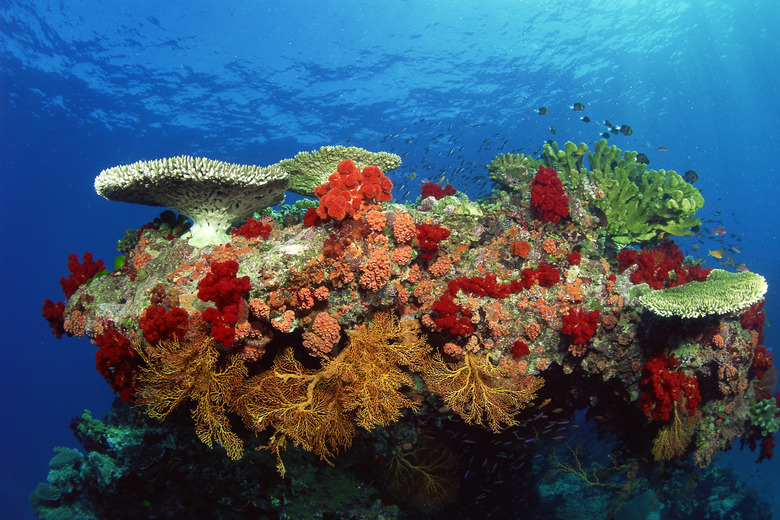What Is The Difference Between LPS And SPS Corals?
Over 6,000 coral species exist globally and are categorized into two types: soft and hard. The difference between soft coral and hard coral is that hard coral has a calcium carbonate skeleton, which contributes to reef building, and soft coral doesn't. Hard corals are further segregated into two broad categories: SPS and LPS. These terms are used to describe corals' appearance and form. SPS coral stands for small polyp stony, while LPS coral stands for large polyp stony.
Colonies of Polyps
Colonies of Polyps
Corals belong to the Cnidaria phylum alongside jellyfish and share the class Anthozoa with anemones. Though many look like plants, they are animals – to be more precise, corals are colonies of animals living together. The individual animals that make up a coral are called polyps. Some polyps can live alone, but most live in a colony.
Each polyp looks like a tiny tube with one hole surrounded by tentacles. The polyp uses these tentacles to collect food and sting potential threats that come near them. Hard coral polyps secrete calcium carbonate at their base, forming protective shells called corallites, which they live inside and which forms the base of a coral reef.
LPS Coral Types
LPS Coral Types
The most significant distinction between LPS corals and SPS corals is their polyp size. LPS corals have much larger, more prominent coral polyps than SPS corals. Often the corallite of LPS corals is poorly visible as the sizeable crowded coral polyps mask it.
For example, Hammer and Frogspawn corals of the genus Fimbriaphyllia, previously Euphyllia, are popular LPS corals grown in aquariums for the graceful appearance of their extended fleshy polyps. Another popular aquarium species is bubble coral (Plerogyra sinuosa), as its large exotic bulbous-shaped polyps bunch together like a pile of bubbles completely covering their corallites. Whisker coral (Duncanopsammia axifuga), commonly called duncans, are famous for their thick tube bodies and prominent tentacles. Because of their large tentacles, LPS corals are more aggressive with their stings than SPS varieties.
Keeping LPS Corals in Aquariums
Keeping LPS Corals in Aquariums
In addition to looking different, LPS and SPS corals have contrasting environmental preferences. In aquarium settings, LPS corals tend to prefer slow water flows. LPS corals are generally thought of as easier to care for because they are more tolerant to chemical changes in the environment, such as higher levels of nitrates and phosphates than SPS corals. However, LPS corals typically require higher calcium levels in the water to grow their corallite bases. Because of this, aquarists must add calcium and alkalinity supplements to support their growth.
SPS Coral Types
SPS Coral Types
While LPS coral descriptions are predominantly about the appearance of their polyps, which often cover their skeletons, leaving them unseen, SPS corals polyps are smaller, so the structure is defined more by their skeleton shapes. For example, Montipora capricornis has a plate-like formation, and M. digitata is made up of hard branches.
Together the tiny polyps give the coral surface the appearance of pores. Bird's nest corals of the Seriatopora genus also have a branched appearance. The small polyps covering the surface of this coral skeletal structure look like tiny brown, yellow, orange, green, pink or purple polka dots.
Because they are more petite, SPS corals tend to grow a lot faster than LPS coral species. Bird's nest corals are one of the fastest-growing SPS corals. In the wild, they grow approximately 0.24 inches over four months in an Australian summer.
Keeping SPS Corals in Aquariums
Keeping SPS Corals in Aquariums
In aquariums, SPS corals are considered more difficult to manage than LPS corals because they prefer faster water flows and a strictly regulated environment with low nitrate and phosphate levels. SPS corals also prefer higher light conditions than LPS corals. However, though they have more significant challenges, one of the benefits aquarists find when keeping SPS corals is they tend to be less aggressive due to their tiny tentacles.
References
- World Wide Corals: The 3 Main Types of Coral
- Reef Systems: Small Polyp Stony SPS Coral
- National Oceanic and Atmospheric Administration Coral Reef Conservation Program: Coral Facts
- National Geographic: Coral
- Pieces of the Ocean: All You Need to Know About SPS, LPS, & Soft Corals
- International Coral Reef Symposium: Summer Growth Rates of Corals at Lord Howe Island, Australia
- Reefs.com: The Bird's Nest Corals: Species of the Genus Seriatopora
- Aquarium Breeder: How to Care for Bird's Nest Corals
- Reefs.com: Montipora Digitata: A Stony Coral for All Hobbyists
- Practical Fishkeeping: Montipora Capricornis
- eAtlas: Caulastrea Furcata
- Tropical Fish Magazine: Give Your Mini-Reef a Bit of the Bubbly
- The Spruce Pets: How to Care for a Duncan Coral
Cite This Article
MLA
Jerrett, Adrianne. "What Is The Difference Between LPS And SPS Corals?" sciencing.com, https://www.sciencing.com/difference-between-lps-sps-corals-8781181/. 20 October 2021.
APA
Jerrett, Adrianne. (2021, October 20). What Is The Difference Between LPS And SPS Corals?. sciencing.com. Retrieved from https://www.sciencing.com/difference-between-lps-sps-corals-8781181/
Chicago
Jerrett, Adrianne. What Is The Difference Between LPS And SPS Corals? last modified March 24, 2022. https://www.sciencing.com/difference-between-lps-sps-corals-8781181/
